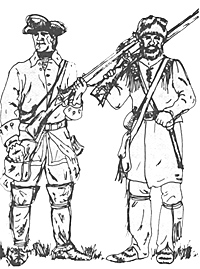
This June I spent five enjoyable days in Toronto, Canada. Though not noted for its military history, there are several museums and stores well worth a visit. The most notable is Fort York, a meticulously preserved Fort built in 1816. Now "manned" by a small group of Government employees equipped as British soldiers of the period, one building in the Fort houses exhibits on Canadian military history while another building is devoted to the Royal Canadian Mounted Police. York, it turns out, was Toronto's. name during the War of 1812. But there were too many Yorks scattered around the world, so Toronto, the original Indian name meaning "meeting place", was later adopted again.
The original Fort, built in the eighteenth century as protection against Indians, had been constructed of green timber and collapsed.
The second Fort York, guarding the eastern approaches to York by land or water, fell to the invading Americans in 1813 during the War of 1812 (incidentally, do the British call it the War of 1812?). This seems to have been the largest pitched battle ever fought near Toronto. 1700 Americans drove back some 700 British regulars, militia and Indians in fighting described as "bitter". The town of York itself was burned and the main magazine in the Fort exploded, killing the American commander. Later Washington, D.C., was burned by the British in retaliation.
The Government tries to maintain complete accuracy in the Fort, even to presently replacing hemmed garrison jackets with unhemmed ones which will fray as the originals did. Two things were of most interest, one was glimpsing the everyday life of a British soldier in garrison and the other seeing the fire drill and actual firing of a Brown Bess. We got a tour of the barracks and officers quarters and the contrast, of course, was startling. Much I found new, being most interested in the ancient and modern periods and knowing_ little about the Napoleonic period. Out of each company of 100 men six, decided by lot, could bring wives with them. There were no separate quarters, you got a corner bunk where you could put up a curtain.
Further, these women did all the cleaning and cooking for the officers (the men cooked for themselves) and did the laundry for the entire Fort. For this exhausting sun-up to sun-down work the women made at most one-half the less than princely "a shilling a day" that the common soldier made. The cooks were up by 5 a.m. heating up the brick oven to make fresh bread for the officers' breakfast. And often the officers held elaborate dinner parties of many courses, there being little else to do in the small town Toronto was then. Still, working in the kitchen was the best work. There you made 10 pence a day, while the laundresses only made 3 pence.
The firing drill was the first I had ever seen and fascinating. I could easily see where all those clouds of smoke came from seeing a Brown Bess fired. Dark, solid colour tunics had a definite usefulness with all that smoke about. Any white uniform must soon have become a dingy grey. Further, I had never realised that there is a back flash when firing a musket, which is where the term side burns comes from (they were grown for protection). All in all a most enjoyable afternoon.
I would also leave liked to visit the Royal Canadian Military Institute. Open only to present and former Canadian officers or members of affiliated clubs elsewhere (none of which I am), I could not go in. But the pamphlet describing the Institute makes it sound eminently interesting.. There is all extensive library (presumably open with special permission to writers and scholers) and a collection of Canadian military artifacts.
As a. resident of New York City, where there are no shops that cater to the wargamer, I was hoping to find some shop stocking miniatures, rules, etc. As it turned out, my hopes were unfounded. One store, Mister Gameways, had an extensive range of boardgames, surpassing any store in NYC, and is well worth a visit by any wargamer interested in board games. But the best stocked hobby store I visited carried only a small selection of Phoenix miniatures. The Toy Shop, the toy store in Toronto, carried, besides a complete line of Britain's and Timpo fi,:ures, a small line of rather expensive, somewhat crude 54mm figures. I never did find where they had been made. But I had never seen them before and a collector might be interested in checking; them out.
I did not have time to meet anyone from the two groups I heard about but there seems to be an active military figures collectors bunch and a large wargaming club, seemingly devoted mainly to board games (for John Hutchings who wrote in the June issue asking for info on Toronto the telephone numbers listed on the leaflet I got were President, Bob Dick, 438-2418, Secretary-Treasurer, Tom Brooks, 661-1458, Editor, Tom Nowak, 961-2851, and Projects, Colin Rice, 925-9467). Though there is not a wealth of activities or places for wargamers to visit in Toronto, the Canadians were so unfailingly friendly that visiting Fort York or any of the stores was always enjoyable.
Back to Table of Contents -- Wargamer's Newsletter # 162
To Wargamer's Newsletter List of Issues
To MagWeb Master Magazine List
© Copyright 1975 by Donald Featherstone.
This article appears in MagWeb (Magazine Web) on the Internet World Wide Web.
Other military history articles and gaming articles are available at http://www.magweb.com